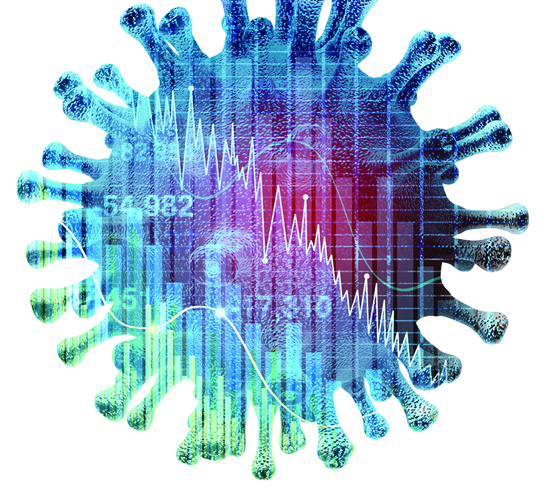By Hank George
| “Although life expectancy in developed countries has increased for much of the past century, U.S. life expectancy began to lose pace with other countries in the 1980s, [and] while life expectancy in these other countries has continued to increase, U.S. life expectancy stopped increasing in 2010 and has been decreasing since 2014.” Steven H. Woolf, MD, MPH, et al. Professor, Department of Family Medicine, Virginia Commonwealth University Journal of the American Medical Association; 322(2019):1996 |
| “The morbidity, mortal, and social and financial devastation of SARS-CoV-2 [COVID-19] has caused throughout the world will have wide-reaching consequences for almost every aspect of life for years to come.” Brit Trogen, MD NYU Langone Medical Center Journal of the American Medical Association; 323(2020):2460[editorial] |
Prologue
In the past 20 years, two new approaches to life underwriting have been widely embraced by life insurers. We call them “super-simplified” and “accelerated.” Both were intended to curry favor with producers and customers by speeding up the underwriting process while also reducing new business acquisition costs.
Super-simplified underwriting enabled insurers to offer substantial amounts of coverage despite fewer application questions and less detailed risk assessments (including no paramedicals or laboratory tests). Higher premium rates compensated for these cutbacks in evidence of insurability.
Then came accelerated underwriting, wherein qualified applicants are insurable for substantial sums. Like super-simplified, paramedicals and lab tests are not required. To be eligible, one must be deemed a preferred risk based on their admitted medical history and a handful of electronic access resources. It differs from super-simplified in one critical aspect: There is no upward pricing adjustment to (at least try) to offset the sizeable added mortality incurred by forgoing routine paramedicals and lab tests.
Some costly, slow access traditional underwriting resources have been eliminated or had their use greatly reduced when less expensive, more rapid access alternatives became available. Some of these novel alternatives have proven protective value; others have a woeful lack of proper vetting. All have been aggressively promoted and frequently accompanied by ham-fisted efforts to denigrate existing resources.
At this critical juncture in our history we face a mammoth challenge.
We must chart a course that continues producing robust mortality gains absolutely critical to our bottom lines … despite the challenges posed by the incipient 2020 Great Recession and the protean consequences of the COVID-19 pandemic.
This article identifies and discusses core factors that I believe will determine how all of this sorts out over the next decade. It also suggests how we can greatly minimize mortality-related adversities via prudent changes in how we underwrite life insurance.
Great Recession of 2008
According to University of Massachusetts Amherst economics professor Richard Wolff, our economy has crashed three times in this century:
- 2000—triggered by dot-com share price inflation
- 2008—triggered by defaulting subprime mortgages
- 2020—triggered by the COVID-19 viral pandemic
Wolff argues that the emerging recession will be “the hugest crash hit.”[1]
“(The 2008 Great Recession) was a major shock. Its timing and depth were largely unanticipated and resulted in levels of aggregate economic stress not experienced since the Great Depression. Few Americans were left untouched.”
Teresa Seeman, PhD
UCLA Geffen School of Medicine
Proceedings of the National Academy of Sciences;
115(2008):3296
These are just some of the consequences we experienced from the 2008 Great Recession:
- Mass layoffs[2]
- Housing values dropped by one-third[2]
- 1.5 million older Americans lost their homes[2]
- Average household net worth was 50% of its 2003 value[3]
- Effects on working life expectancy did not differ between high school and college graduates[4]
- Significantly increased mortality from external causes occurred at all levels of education[5]
This economic devastation persisted and widening disparities after 2008 can be explained in large measure by that event[6,7,8] and most important from our perspective that Great Recession significantly raised all-cause mortality.
“Even policies … that successfully improve earnings and jobs, or redistribute income, will take years to reverse the mortality and morbidity increase [and] those in midlife now are likely to do much worse in old age than those currently older than 65.”
Anne Case, PhD
Emeritus Professor of Economics
Princeton University
Brookings Papers on Economic Activity; 2017:397
(Greater) Great Recession of 2020
“Coronavirus disease 2019 (COVID-19) has created an economic crisis alongside a health care crisis.”
David Cutler, PhD
Professor of Applied Economics
Harvard University
Journal of the American Medical Association;323(2020):2237[editorial]
The June 23 issue of The Atlantic featured articles on the 2020 Great Recession. In “The Looming Bank Collapse,” Frank Partnoy opined that this time we might not be able to save our financial system poised as it is “on the cusp of calamity.”
Early on, the picture is not very rosy. Unemployment levels “remain at historic levels.”[9]
“Of the 32.5 million workers who are either officially unemployed or otherwise out of work because of the virus, only 14.8 million workers (or 45.6%) can reasonably expect to be called back to a prior job, which means 17.6 million (or 54.4%) cannot.”
Heidi Shierholz, PhD
Economic Policy Institute
“The staggering unemployment figures—devastating as they are—do not fully capture the degree to which the coronavirus has disrupted professional life across the country. … Even well-connected high earners are suddenly in unfamiliar territory.”[10]
This level of unemployment begets profound consequences, including higher mortality in all socioeconomic groups.[11]
“The prospect of unemployment plagues workers and their families with anxieties. The experience of unemployment is associated with rising levels of depression, alcoholism, drug abuse, marital problems, child abuse, and other social ills. It is likewise associated with declining levels of worker self-esteem, job skills, personal savings, and physical and mental health.”
Richard D. Wolff, PhD
Emeritus Professor of Economics
University of Massachusetts Amherst
www.rdwolff.com
There have been a number of recent studies examining unemployment and mortality.
Belgian investigators analyzed the mortality impact from unemployment on their 25- to 59-year-old countrymen eligible to work over a decade (2001–2011).[12] Mortality rates were calculated per 100,000 person years.
Age-Standardized All-Cause Mortality Rates
|
| Unemployed | Employed | Difference |
| Men | 565.8 | 243.1 | 322.7 |
| Women | 195.1 | 121.0 | 73.2 |
The mortality rate in men was 2.3 times higher if they were unemployed!
Harvard researchers studied all-cause mortality based on the impact of job loss during phases of the business cycle. Their subjects were 45 to 64 years old at baseline:
All-Cause Mortality Business Cycle Job Loss
| Quantile | No | Yes |
| Q1—Boom Economy | 1.00 | 1.00 |
| Q2 | 0.88 | 1.28 |
| Q3 | 0.87 | 1.24 |
| Q4 | 0.76 | 1.61 |
| Q5 | 0.65 | 1.24 |
| Q6—Recession | 0.67 | 2.11 |
Note statistically significant findings in bold
Once again, the unemployed, by virtue of job loss, had over two times higher all-cause mortality during recessionary times.[13]
A Spanish mortality assessment found currently unemployed individuals previously enjoying high income and substantial wealth nevertheless had worse mortality outcomes than matched control subjects with smaller homes, fewer automobiles, and so on.[14]
The relative increase in death risk in the wake of financial crises is akin to that with a new diagnosis of coronary artery disease.[15] And the heightened death risk incited by unemployment is “causally related to increased mortality rates in the subsequent 10 years.”[16]
The mortality attributable to Great Recession is not limited to short-term deaths.[17] A University of Washington study models forecasts that while Spain will pass Japan into first place in life expectancy, the United States will fall to 64th place.[18]
It is widely held that the driver of death from economic downturns is stress, which induces “negative wealth shock.”[17] These wealth shocks progress to chronic stress, a state of physiologic dysregulation that gives rise to chronic inflammation, impaired coping abilities, and greater indulgence in unhealthy practices (such as heavy drinking).[19, 20, 21, 22]
In a 2018 study, Pool (Northwestern University) and his colleagues followed 8,714 subjects, ages 51 and older, for up to 17.7 years. Wealth shocks were identified on the basis of major changes in net worth. Roughly 25% of subjects experienced a major negative wealth shock (loss of 75% or more of net worth). Their mortality risk was 50% higher than that reported for participants spared a major net worth decline. And if the wealth shock resulted in loss of the primary residence, mortality increased to 87%.[23]
Deaths of Despair
“Deaths of despair have been on the rise for the last decade and in the context of COVID-19, deaths of despair should be seen as an epidemic within a pandemic.”
Stephen Petterson, PhD
American Academy of Family Physicians
WellbeingTrust.org
May 8, 2020
These deaths are triggered by economic hard times and become so prevalent that they more than offset any mortality improvements from fewer heart disease and stroke deaths.[24, 25, 26]
Consensus deaths of despair occur as a consequence of alcohol intoxication, alcoholic liver damage, drug overdose, and suicide.[27] According to data from the Centers for Disease Control and Prevention (CDC), deaths of despair per 100,000 increase linearly from age 25 to 55, plateau at 55 to 65, and then decline.
The cumulative adverse emotional, behavioral, biological, and cognitive effects imposed by Great Recessions catalyze steeply in increased deaths of despair.[28, 29]
“The deaths of despair literature not only implicates despair as a psychological and social construct that triggers multiple causes of death, it also suggests that pathways to deaths of despair may stretch across multiple years and decades.”
Lilly Shanahan, MD
University of Zurich
American Journal of Public Health; 109(2019):854
Indeed, if recovery from COVID-19 recession is at the same rate as the 2008 Great Recession, excess deaths of despair “will remain excess through at least 2029.”[30]
Alcohol Use and Great Recession Mortality
“It will be only in hindsight that we can measure the effect of social isolation, job losses and financial meltdown on the alcohol balance sheet.”
Llora Finlay
Chair, Commission on Alcohol Harms, House of Lords, UK
British Medical Journal; 369(2020):m1987
The 2008 Great Recession had a dramatic impact on the prevalences of heavy drinking, binge drinking, and intoxication.31 Self-medication with alcohol and other substances served as a means of coping with job loss.[32] Alcohol abuse also increased in those who did not lose their jobs but saw increased workloads, persistent job insecurity, etc.[33]
Binge drinking (bingeing) is most often defined as consuming at least five (male) or four (female) alcoholic drinks on a single drinking occasion. Great Recession bingeing rates were 64% greater in those who lost their jobs,which is particularly significant because bingeing accounts for most trauma-related alcohol mortality.[34]
Between 2007 and 2014, hospitalizations for alcoholic cirrhosis increased 33% overall and 178% in patients with three or more complications.[35] The increase in alcoholic liver disease deaths occurred in younger people as compared to those age 65 and older prior to 2010. Among 25- to 34-year-olds, cirrhosis mortality went up 10.5% per years from 2009 onward.[36]
Clinical physicians at UCLA Medical Center report a “significant increase in alcohol-related problems” especially at ages 30 to 49. Many were heavier social drinkers for years and the imposed isolation and related consequences of the COVID-19 pandemic “tipped them over the edge.”3[37]
Propelled by the 2008 Great Recession, alcoholic liver damage is now the No. 1 cause of liver-related death in the U.S.[38] Alcoholic liver disease mortality in 2017 was the highest of any year since 1979.[39]
Andrew H. Moon, MD, MPH
“Increasing ALD [alcoholic liver disease] mortality mirrors declines seen in mental health and ability to work and increases in suicide and drug overdoses seen in middle-aged Americans.”
University of North Carolina School of Medicine
American Journal of Gastroenterology; 115(2020):79
Vanthomme sorted the highest relative risks of mortality in unemployed vs. employed individuals. In men, three of the top five were due to alcohol. The leading death risk in unemployed men and women was in the subset defined as “Mental Disorder due to Alcohol.”[40]
Demographics consistent with those most likely to apply for larger individual life products closely parallel those prevalent in contemporary alcohol abusers. For example:
“Those with unhealthy drinking habits … were white, U.S. born, healthy, better educated and wealthier.”
Daniel Weisz
Mailman School of Public Health
Columbia University
Alcohol and Alcoholism
E-published April 29, 2020
Patient underreporting of their alcohol consumption and inadequate alcohol abuse screening are regarded as major barriers to identifying and treating alcohol use disorder.[41, 42] Laboratory screening for markers associated with heavy drinking is seldom done by American physicians.

My underwriting experience shows that heavy (and even moderate) alcohol consumers habitually understate their consumption when applying for life insurance. If they do not have significant liver disease and have not been treated for alcohol use disorder, most routine screening assets contribute little to efforts to pinpoint higher-mortality-risk drinkers.
The most effective test we can afford to use to screen for markedly heavy drinking, bingeing, and alcoholic liver damage is gamma-glutamyltransferase (GGT).[43, 44, 45] GGT is inexpensive but rarely used clinically. Thus we seldom see GGT results reported in medical records.[46, 47]
Good news: GGT is a component of our screening blood profile.
Bad news: Accelerated underwriting has eliminated a sizeable portion of lab testing, especially under age 60 for amounts as large as several million dollars.[48]
Our self-imposed inability to identify the burgeoning population of alcohol abusers could well be an impactful contributor to the coming COVID-19/Great Recession underwriting apocalypse.
To put it more bluntly: Our mortality results are apt to get clobbered by shorter-duration alcohol-mediated mortality.
Drug abuse is also a likely contributor to deaths of despair over the next decade.
Based on 28 studies, Nagelhout et al. found that use of drugs of abuse increased substantially during Great Recessions, largely for the same reasons as alcohol abuse.[48] Fatal drug overdoses increased fivefold between 1999 and 2017, mainly due to opioid drugs.[49] After an extended interval of gradual decline, cocaine-related deaths increased substantially in the wake of the Great Recession.[50]
We face the same obstacles that we do with alcohol abuse. Steep cutbacks in lab testing have greatly reined in capacity to identify applicants at high risk for deaths due to opioids, cocaine, and other drugs of abuse at precisely the time when we can least afford to overlook these risks.
Mental Illness and Great Recession Mortality
“Even if most individuals prove resilient, the toll of COVID-19 disruptions and the sheer numbers involved have experts warning of a mental illness tsunami.”
Lydia Denworth
Contributing Editor
Scientific American
June 18, 2020
The psychosocial burden of physical distancing, loneliness, fear of viral infection, complex bereavement, financial deprivation, and loss of jobs and homes are all identified by experts as catalysts for a dramatic upsurge in mental illness diagnoses.[52, 53, 54, 55, 56, 57, 58]
“Never before have we experienced social isolation on such a massive scale. In times of distress, crisis, or disaster, human resilience depends on the richness and strength of social connections, as well as active engagement in groups and communities. Over recent years, evidence emerging from various disciplines has made it abundantly clear: loneliness may be the most potent threat to survival and longevity.”
Danilo Bzdok, PhD
McGill University, Montreal
Trends in Cognitive Sciences
E-published May 1, 2020
An April 2020 Kaiser Family Foundation survey found COVID-19 psychopathy to be equally common in high- vs. low-income households. The prevalence was substantial in young (69%), middle-aged (55%), and elderly (45%) individuals enrolled in its health care network.
Two serious psychiatric conditions prevalent during the Great Recession and now being encountered in COVID-19 survivors are major depressive disorder (MDD) and post-traumatic stress disorder (PTSD).[59, 60, 61, 62]
“PTSD is associated with enormous personal and societal costs including elevated risks of suicidality and overall mortality, functional impairment and reduced quality of life, and more psychiatric and medical comorbid conditions.”
Jennifer J. Vasterling, PhD
VA Boston Healthcare System
American Journal of Epidemiology; 184(2016):796
PTSD contributes to mortality indirectly via substantially increased risks of alcohol, cocaine, and opioid abuse; fair to poor self-rated health; heavy smoking; coexisting mood and personality disorders; and gun violence and suicide.[63, 64, 65, 66]
“Doctors at John Muir Medical Ce nter in Walnut Creek say they have seen more deaths by suicide during this quarantine period than deaths from COVID-19 virus. ‘The numbers are unprecedented. … We’ve seen a year’s worth of suicide attempts in the last four weeks.’”
ABC News San Francisco
May 21, 2020
The World Health Organization reported 5,000 excess suicides in 2007–2009 due to unemployment and related issues.[67] Job loss increased suicide fourfold and eightfold in Australian men and women, respectively, during recession.[68]
Similar trends are emerging for the 2020 Great Recession and experts expect mental disorders and their consequences to be highly prevalent in the wake of the COVID-19 pandemic.[69, 70]
Mood disorders reduce life expectancy by an average of eight years in men and six years in women.[71] Underwriting psychiatric illness is more difficult than for most medical conditions.
- There are no lab tests or other quantifiable mortality markers attributable to the mental disorder.
- Besides substance abuse, most premature deaths are due to traumatic events and suicide, both of which are difficult risks to assess.[72]
- The key underwriting resources are review of all of the applicant’s medical records and tests for excess alcohol consumption plus undisclosed opioid and illicit drug use.
- Rx records have many false positives because of widespread off-label (unapproved) use of most psychiatric drugs for physical disorders.[73]
- Various easily measured demographic considerations correlate well with suicidal behavior but are not appropriate underwriting variables because of disparate discrimination against protected classes.[74, 75]
The ‘Second Epidemic’
There is growing concern for a “second epidemic” due to forgone care of life-threatening disorders during the COVID-19 pandemic.[76]
“The consequences of COVID-19 are not limited to those stricken with the virus but include collateral damage to patients suffering from other diseases. … Millions of Americans are suffering from the simultaneous loss of ‘health and wealth,’ the effects of which will likely continue far beyond the current COVID-19 crisis.”
Joseph E. Ebinger, MD
Cedars-Sinai Medical Center, Los Angeles
Journal of the American College of Cardiology
E-published May 22, 2020
In a May consumer survey, 41% of respondents said they have delayed or canceled health care for reasons directly attributable to the current pandemic.[77] Cancer care has been “disproportionately affected by COVID-19.”[78]
“Cancers being missed now will still come to light eventually but at a later stage and [with a] worse prognosis. … There can be no doubt that the COVID-19 pandemic is causing delayed diagnosis and suboptimal care for people with cancer.”
Norman E. Sharpless
Director, National Cancer Institute
Science; 362(2020):1890[editorial]
According to Sharpless, at least 10,000 extra deaths from just two malignancies—breast and colon carcinoma—attributable to delayed diagnosis and/or treatment are expected over the next decade.
A survey of British surgeons showed 58% agreeing that the overall COVID-19 effect will strongly compromise cancer care with negative survival effects.[79] Similarly, surgeons specializing in the liver, pancreas, and bile ducts expect a sizeable portion of patients to “become inoperable before normal service resumes.”[80]
Cancer is the leading medical cause of early-duration death claims. Sufficient underwriting of high-risk applicants requires access to medical records. The frequency of attending physician statement (APS) procurement has decreased in recent years. Expect a notable uptick in APS ordering that is likely to persist throughout this decade.
Circulatory Disease Mortality
Since the 1960s, the life insurance industry has been a huge, albeit incidental, beneficiary of ongoing health habit improvements such as major decreases in cigarette smoking and saturated fat consumption.
They fueled progressive mortality rate improvements on all life coverage. These decreases in mortality disproportionately affect the top 50% of the socioeconomic spectrum, where we sell the vast majority of six-figure-plus individual life policies.
This incredible “free lunch” has largely ended for various reasons including the obesity, diabetes, and metabolic syndrome “epidemics.” And now we can add the 2020 Great Recession and COVID-19 pandemic.
With the advent of the COVID-19, there have been substantial decreases in emergency room visits for suspicious symptoms and inpatient admissions of patients experiencing acute coronary and cerebrovascular (stroke, transient ischemic attack) events.[81, 82, 83]
This translates to a formidable reservoir of future applicants who should have had proper diagnostic evaluations for suspicious symptoms of mainly chronic and usually progressive cardiovascular diseases.
During the 2008–2010 “recessionary job market,” the risks of heart attack and stroke were threefold higher after adjusting for 27 potential risk factor confounders.[84] Deaths from these two major circulatory events in Ireland were 16% greater in the wake of the 2008 Great Recession.[85] A 13-study literature review revealed that recession-mediated job insecurity correlated with a 19% higher coronary disease risk after multivariate adjustment.[86]
Psychiatric conditions mediated by stress combined to enhance physiological dysregulation and the odds of having cardiovascular disease.87 Persistent moderate/severe mental disorders increase circulatory system mortality nearly fourfold.[88]
To make matters worse, CDC data show that deaths attributable to hypertension increased 92.3% since 1999 with the greatest impact in males under age 50 and homeowners.[89, 90, 91] And the 50% increase in hypertension risk affecting heavy drinkers is one of many synergistic relationships between deaths of despair.[92]
PICS
“The glittering allure of ‘normalcy’ that waits on the other end of these stay-at-home orders is a mirage.”
McKay Coppins
The Atlantic
May 8, 2020
Post-intensive care syndrome (PICS) is certain to increase mortality over the next five to 10 years because inpatient COVID-19 survivors “will have significant multi-domain impairment requiring ongoing support.”[93]
Four out of every five COVID-19 patients leaving intensive care have unresolved physical, psychiatric, and/or cognitive manifestations that do not resolve on their own. These include chronic and often multisite pain syndromes, ongoing opioid Rx, neurological dysfunction, fatigue/weakness, and a 50% risk of chronic disability.[94, 95, 96]
PICS also fosters two potent mortality risks: pervasive loneliness and breakdown of the patient’s social network.[96] And there is a sizeable increase in subsequent decompensated alcoholic liver disease in PICS survivors.[97]
The Underwriting Apocalypse
Prior to the advent of super-simplified and accelerated underwriting, baseline medical assessment of mortality risk was anchored in the finest resources we have ever had to underwrite Great Recession and post-viral pandemic deaths of despair.
Several (MIB, pharmacy, and motor vehicle records) remain in our screening armamentarium and another has been added (LabPiQture).
Unfortunately, deployment of the following proven risk assessment assets has steeply declined, resulting in the loss of mortality markers needed to properly underwrite deaths of despair.
- Paramedicals—blood pressure, accurate build data
- Blood profile—GGT, our best binge drinking/alcoholic liver disease marker
- Urine/oral fluid profiles—cocaine metabolite marker benzoylecgonine, cotinine for tobacco ingestion, HIV-1
- Blood alcohol—alcohol use in alleged teetotalers/recovered alcoholics as well as surreptitious drinking early in the day
- Carbohydrate deficient transferrin (CDT)—excessive drinking
- Opioid tests—an essential companion of Rx records
We are far less inclined to pursue attending physician statements in 2020 than at any time in the past 50 years. The APS is the underwriting resource of choice in psychiatric disorders and for that most chronic sequelae of PICS.
In-depth financial underwriting with access to sufficient evidence also makes an important contribution here.
Some Big Data tools are tainted with disparate discrimination against protected classes and thus destined to have an (appropriately) foreshortened role in underwriting.
Most other predictive analytics facilitate faster and less-costly underwriting. However, they offer little protective value for navigating the barrage of impending excess Great Recession/COVID-19 mortality we must deal with over the next decade.
When you cobble together all the issues we have documented, it becomes crystal-clear that we have two choices. The one we make could determine the profitability, or lack thereof, over the ensuing decade.
Either bite the bullet and substantially increase paramedical/lab test screening, selective APS acquisition, and sufficient conventional financial underwriting—or hunker down to endure an unprecedented, self-imposed underwriting apocalypse defined by multiple years of net mortality losses between now and 2025–2030.
HANK GEORGE, FALU, worked for more than 43 years in the life insurance industry and has written numerous features for Contingencies, including the EXCEL-award-winning cover feature, “Smoke and Mirrors—Marijuana Use and Life Underwriting.”
| The views in this article are those of the author and do not necessarily represent the official views of the American Academy of Actuaries. |
References
Note: “E-published…” is the date an article was published online prior to being included in the journal’s print edition.
[1] https://www.counterpunch.org/2020/06/19/how-workers-can-win-the-class-war-being-waged-against-them/ [2] Boen. Social Science and Medicine. 150(2016):221 [3] Frone. Psychology of Addictive Behavior. 30(2016):158 [4] Dudel. Demography. 54(2017):2101 [5] Case. Proceedings of the National Academy of Sciences. 112(2015):15078 [6] Glei. PLoS One. 14(2019):e0214947 [7] Kaplan. Injury Prevention. 21(2015):35d [8] Richman. 31(2012):158 10 New York Times, May 28, 2020 [9] https://www.dol.gov/ui/data.pdf [10] New York Times 5/28/20 [11] Shierholz. Economic Policy Institute.https://www.epi.org/blog/nearly-11-of-the-workforce-is-out-of-work-with-zero-chance-of-getting-called-back-to-a-prior-job/ [12] Vanthomme. PLoS One. 14(2019):e0216145 [13] Noelke. American Journal of Public Health. 104(2014):e126 [14] Alonso. Journal of Epidemiology and Community Health. 71(2017):736 [15] Majed. Stroke. 46(2015):1371 [16] Roelfs. Social Science and Medicine. 72(2011):840 [17] Burgard. The Annals of the American Academy of Political and Social Science. 650(2013):194 [18] Foreman. Lancet. 392(2018):2052 [19] Catalano. Annual Review of Public Health. 32(2011):431 [20] Dave. Social Science and Medicine. 74(2012):16 [21] Drentea. Society and Mental Health. 5(2014):16 [22] Mortensen. JAMA Internal Medicine 173(2013):315 [23] Poole. Journal of the American Medical Association. 319(2018):1341 [24] Shiels. Lancet Public Health. 4(2019):e97 [25] Strumpf. Social Science and Medicine. 187(2017):11 [26] Koh. Journal of the American Medical Association. 322(2019):1963[editorial] [27] Masters. Biodemography and Social Biology. 63(2017):31 [28] Glei. PLoS One. 14(2019):e0214947 [29] Shanahan. American Journal of Public Health. 109(2019):854 [30] Petterson. American Academy of Family Physicians Wellbeing Trust.org. May 8, 2020 [31] Frone. Psychology of Addictive Behavior. 30(2016):158 [32] Richman. Journal of Addictive Disorders. 31(2012):158 [33] Green. Journal of Happiness Studies. 17(2016):389 [34] O’Harhay. European Journal of Public Health. 24(2014):410 [35] Dang. American Journal of Gastroenterology. 115(2020):96 [36] Tapper. British Medical Journal. 367(2018):k2817 [37] Hein. Medscape.com. May 6, 2020 [38] Paik. Hepatology Communications. 4(2020):890 [39] Moon. American Journal of Gastroenterology. 115(2020):79 [40] Vanthomme. PLoS One. 14(2019):e0216145 [41] Shafer. Annals of Family Medicine. 17(2019):161 [42] Shah. Clinical Gastroenterology and Hepatology. 17(2019):23200 [43] Niemelā. Scandinavian Journal of Clinical and Laboratory Investigation. 79(2019):58 [44] Kristenson. Preventive Medicine. 9(1980):108 [45] Nivukoski. Alcohol. 78(2019):13 [46] Kwo. American Journal of Gastroenterology. 112(2017):1 [47] Smellie. British Medical Journal. 344(2012):e1169 [48] Rankin. LOMA Resource. May/June 2020:16 [49] Nagelhout. International Journal of Drug Policy. 44(2017):69 [50] Wolff. Journal of the American Medical Association. 322(2019):1996 [51] Pavarin. European Addiction Research. 26(2020):10 [52] Kola. Lancet. E-published June 2, 2020[editorial] [53] Roca. British Medical Journal. 369(2020)m2520[editorial] [54] McLaughlin. Psychological Medicine. 42(2012):1441 [55] Frasquilho. BMC Public Health. 16(2016):115 [56] Sareen. Archives of General Psychiatry. 68(2011):419 [57] Selenko. Journal of Occupational and Organizational Psychology. 84(2011):723 [58] Rimmer. British Medical Journal. E-published 6/18/20[editorial] [59] Nikayin. General Hospital Psychiatry. 43(2016):23 [60] Riumallo-Hurt. International Journal of Epidemiology. 43(2014):1508 [61] Rogers. Lancet Psychiatry. E-published May 18, 2020 [62] Vindegaard. Brain, Behavior and Immunity. E-published May 30, 2020 [63] Flanagan. Current Psychiatric Reports. 18(2016):70 [64] Hassan. Drug and Alcohol Dependence. 179(2017):260 [65] Gradus. Clinical Epidemiology. 9(2017):251 [66] Hoge. American Journal of Psychiatry. 164(2007):150 [67] Nordt. Lancet Psychiatry. 2(2015):239 [68] Milner. International Journal of Epidemiology. 43(2014):1500 [69] Gunnell. Lancet. E-published April 21, 2020 [70] Rauch. Medscape. May 14, 2020 [71] Plana-Ripoli. Lancet. 344(2019):1827 [72] Taylor. Annals of Internal Medicine. E-published June 1, 2020 [73] Milliman Intelliscript Rx Guide [74] Puterman. Proceedings of the National Academy of Sciences. E-published June 22, 2020 [75] Malik. JAMA Network Open. 3(2020):e208741 [76] Chokski. Journal of the American Medical Association. 32(2020):1996 [77] King. Fierce Healthcare. May 21, 2020 [78] Rosenbaum. New England Journal of Medicine. 24(2020):2368[editorial] [79] Nevermann. British Journal of Surgery. E-published June 10, 2020[editorial] [80] Labib. British Medical Journal. 369(2020):m2153 [81] Lange. Mortality and Morbidity Weekly Report. 69(June 22,2020):1 [82] Braiteh. American Heart Journal. 226(2020):147 [83] Solomon. New England Journal of Medicine. E-published August 19, 2020 [84] Noelke. American Journal of Epidemiology. 182(2015):873 [85] Osman. Irish Medical Journal. 110(21017):597 [86] Virtanen. British Medical Journal. 347(2013):l4746 [87] Bacon. British Medical Journal. 365(2019):l2577[editorial] [88] Stewart. Heart. 103(2017):1860 [89] Forester. PLoS One. 15(2020):e0225207 [90] Wang. Journal of the American College of Cardiology. 75(2020):2921 [91] Seeman. Proceedings of the National Academy of Sciences. 115(2018):3296 [92] Sterling. JAMA Network Open. 3(2020):e204687 [93] Kemp. British Journal of Anesthesia. E-published May 21, 202094 Nainggolan. Medscape. June 18, 2020 [95] Vittori. Anesthesia and Analgesic Journal. E-published April 27, 2020 [96] Bzdok. Trends in Cognitive Sciences. E-published June 2, 2020 [97] Da. Hepatology. E-published May 5, 2020




